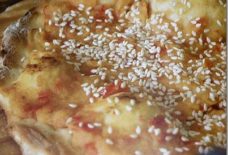A Palestinian Dress Story: Spicing Up Tradition with Modernity
Houston, Texas— Last weekend, the Jones Plaza in downtown Houston was full of people eager to learn more about the Palestinian culture. In one corner, you can spot different merchandise such as souvenirs, clothes, food, photographs, books, and jewelry, all reflecting Palestine in one way or the other.
In another corner, you see groups of people dancing the famous dabkeh, or smoking the hookah, while others are enjoying the different musical performances and competitions taking place on stage.
However, one thing that no one seems to miss is the groups of young ladies wearing the traditional Palestinian dresses, known in Arabic as Al-Thob. These dresses come in different colors with different embroidered designs, reflecting the different cities they originate from.
For example, the Ramallah dress is white because in the past it was made of white linen, worn mostly in summer. According to the book Palestinian Tatreez, by Widad Kewar and Tania Tamari Nasser, women in Ramallah used to make also a head cover that has designs matching the ones on their dresses. Black and red threads were the main two components used in cross stitching the embroideries, known in Arabic as Tatreez.
Another dress comes from Gaza, and it is mainly made out of wool and cotton. Embroidery designs on the Gaza dresses were usually big in size, and they were characterized by their fancy colors.
Some dresses from other cities are filled with embroidery, like the ones from Jaffa, compared to dresses from Nablus and Tulkarem, which have the minimal amount of embroidery on them. The main reason for this is the fact that women in Jaffa were married to merchants, so they did not have to work, and they had a lot of time to spend on embroidery. On the other hand, women in places like Nablus work in the field, and have no time for making a lot of embroidery on their dresses.
If you look closely at the embroidery designs on these traditional dresses, you will notice that the shapes resemble parts of Palestine, such as flowers, which resemble spring, and triangles, which are a symbol of cypress trees.
But with the fast rhythm of our lives, and the need for practicality in clothing and fashion, such traditional clothing is becoming gradually just for display purposes. Women do not wear the thob every day; they just wear it on traditional or cultural occasions, such as the above mentioned festival. However, there are people who are trying to change that approach to make Palestinian embroidery, or tatreez part of our everyday life.
The Purple Threads is a small business that came all the way from Dubai, in the United Arab Emirates, to participate at the Palestinian Festival in Houston. The shop, which is owned by Jafra Allan and her partner Loona Shaheen specializes in making modern fashion with designs of Palestinian embroidery. The two ladies created The Purple Threads “to spice up tradition with a touch of modernity,” they say.
The clothing line business was launched back in 2012, with stylish embroidered dresses, but later expanded their collection to include shirts, shawls, skirts, and giveaways.
“We have accomplished so many goals with this project,” says Jafra Allan. “We are reviving the Palestinian embroidery, by making it more appealing to younger people, and creating work opportunities for Palestinian women to make embroideries on our clothes, because all our products are handmade.”
Finding the right type of market for such products is a challenge, says Allan. Deciding to come all the way from the Middle East to Houston,Texas was no easy decision, but The Purple Threads decided to make the journey after all to explore how people in the US would perceive such a fashionable product.
“We believe the US is a great market for our style of fashion. We did great at the Houston Palestinian festival, and we might think seriously about expanding to reach different communities in the US.”
In their designs, Allan and her partner, Loona Shaheen, focus on the colorful aspect more than anything, and that is clear in their use of vibrant colors that reflect modernity and youthfulness.
“If you look at our name, we have used a color in it; purple, which holds unique characteristics according to Roman philosopher Epictetus. We have used colors that you don’t usually see with embroidery. We have turquoise, peach, lime, and fuchsia; all are colors which were never introduced into Palestinian traditional dresses,” says Allan.
Allan believes tradition is so valuable, especially when it comes to Palestine.
“I think our conflict with Israel is not just political, it is also cultural. Israel stole our land, and now it’s trying to steal our culture and traditions. It is our duty as young people to protect this tradition and pass it on to the future generations.
“Palestinian women have always been known for their lavishly embroidered clothes, whether they are rich or poor. Each pattern woven told a story of intellect, status and origin. Our aim is to bring this tradition back but on modern day clothes.
“However, our love for modernity and fashion should never stop us from owning a Palestinian traditional dress. In our eyes, it will always stay the most fashionable and precious piece of garment,” Allan concludes.
Samya Ayish
Contributing Writer
Arab America





